Possible Mechanism of Phytoplankton Blooms at the Sea Surface after Tropical Cyclones
Abstract
1. Introduction
2. Materials and Methods
2.1. Data
2.1.1. Tropical Cyclones Data
2.1.2. Satellite Data
2.1.3. Reanalysis and Model Data
2.2. Methods
2.2.1. Ekman Pumping Velocity
2.2.2. Depth-Integrated Chl-a
3. Results
3.1. The Changes of Phytoplankton Chl-a before and after the Passage of Tropical Cyclones
3.2. Vertical Distribution of Temperature and Salinity before and after the Passage of Tropical Cyclones
3.3. Change of Wind Stress before and after the Passage of Tropical Cyclones
3.4. Spatial Variation of Climatic Background Field
4. Discussion
4.1. Redistribution of Chl-a Caused by Vertical Mixing of Tropical Cyclones
4.2. Possible Mechanism of Phytoplankton Blooms in Surface Layer after Tropical Cyclones Transit of Different Intensity
5. Conclusions
Author Contributions
Funding
Data Availability Statement
Acknowledgments
Conflicts of Interest
References
- Zhou, L.; Chen, D.; Lei, X.; Wang, W.; Wang, G.; Han, G. Progress and perspective on interactions between ocean and typhoon. Chin. Sci. Bull. 2018, 64, 60–72. [Google Scholar] [CrossRef]
- GB/T 19201–2006; Chinese National Standard Intensity Category for Tropical Cyclones. China Standard Press: Beijing, China, 2006.
- Smith, V.H. Responses of estuarine and coastal marine phytoplankton to nitrogen and phosphorus enrichment. Limnol. Oceanogr. 2006, 51 (1 Pt 2), 377–384. [Google Scholar] [CrossRef]
- Werdell, P.J.; Bailey, S.W.; Franz, B.A.; Harding, L.W.; Feldman, G.C.; Mcclain, C.R. Regional and seasonal variability of chlorophyll-a in Chesapeake Bay as observed by SeaWiFS and MODIS-Aqua. Remote Sens. Environ. 2009, 113, 1319–1330. [Google Scholar] [CrossRef]
- Zhao, H.; Zhang, S. Review on Spatial-Temporal Variation of China’ Offshore Phytoplankton Chlorophyll and Primary Productivity and Their Variational Mechanism. J. Guangdong Ocean. Univ. 2014, 34, 98–104. [Google Scholar]
- Chen, Y.; Zhao, H. Spatial distribution of the summer subsurface chlorophyll maximum in the North South China Sea. PLoS ONE 2021, 16, e0248715. [Google Scholar] [CrossRef] [PubMed]
- Letelier, R.M.; Karl, D.M.; Abbott, M.R.; Bidigare, R.R. Light driven seasonal patterns of chlorophyll and nitrate in the lower euphotic zone of the North Pacific Subtropical Gyre. Limnol. Oceanogr. 2004, 49, 508–519. [Google Scholar] [CrossRef]
- Takahashi, M.; Hori, T. Abundance of picophytoplankton in the subsurface chlorophyll maximum layer in subtropical and tropical waters. Mar. Biol. 1984, 79, 177–186. [Google Scholar] [CrossRef]
- Siswanto, E.; Ishizaka, J.; Yokouchi, K. Estimating Chlorophyll-a Vertical Profiles from Satellite Data and the Implication for Primary Production in the Kuroshio Front of the East China Sea. J. Oceanogr. 2005, 61, 575–589. [Google Scholar] [CrossRef]
- Brooks, D.A. The Wake of Hurricane Allen in the Western Gulf of Mexico. J. Phys. Oceanogr. 1983, 13, 117–129. [Google Scholar] [CrossRef]
- Black, P.G. Ocean Temperature Changes Induced by Tropical Cyclones; The Pennsylvania State University: State College, PA, USA, 1983. [Google Scholar]
- Brink, K.H. Observations of the Response of Thermocline Currents to a Hurricane. J. Phys. Oceanogr. 1989, 19, 1017–1022. [Google Scholar] [CrossRef]
- Dickey, T.; Frye, D.; Mcneil, J.; Manov, D.; Nelson, N.; Sigurdson, D.; Jannasch, H.; Siegel, D.; Michaels, T.; Johnson, R. Upper-Ocean Temperature Response to Hurricane Felix as Measured by the Bermuda Testbed Mooring. Mon. Weather. Rev. 1998, 126, 1195–1201. [Google Scholar] [CrossRef]
- Fisher, E.L. Hurricanes and the sea-surface temperature field. J. Meteorol. 1958, 15, 328–333. [Google Scholar] [CrossRef]
- Babin, S.M.; Carton, J.A.; Dickey, T.D.; Wiggert, J.D. Satellite evidence of hurricane-induced phytoplankton blooms in an oceanic desert. J. Geophys. Res. Ocean. 2004, 109. [Google Scholar] [CrossRef]
- Zheng, G.; Tang, D. Offshore and nearshore chlorophyll increases induced by typhoon winds and subsequent terrestrial rainwater runoff. Mar. Ecol.-Prog. Ser. 2007, 333, 61–74. [Google Scholar] [CrossRef]
- Sun, L.; Yang, Y.; Tao, X.; Lu, Z.-M.; Fu, Y. Strong enhancement of chlorophyll a concentration by a weak typhoon. Mar. Ecol. Prog. Ser. 2010, 404, 39–50. [Google Scholar] [CrossRef]
- Wang, J.-J.; Tang, D.L. Phytoplankton patchiness during spring intermonsoon in western coast of South China Sea. Deep. Sea Res. Part II Top. Stud. Oceanogr. 2014, 101, 120–128. [Google Scholar] [CrossRef]
- Zhao, H.; Wang, Y. Phytoplankton Increases Induced by Tropical Cyclones in the South China Sea During 1998–2015. J. Geophys. Res. Ocean. 2018, 123, 2903–2920. [Google Scholar] [CrossRef]
- Chen, Y.; Shi, H.; Zhao, H. Summer Phytoplankton Blooms Induced by Upwelling in the Western South China Sea. Front. Mar. Sci. 2021, 8, 740130. [Google Scholar] [CrossRef]
- Zhao, H.; Han, G.; Zhang, S.; Wang, D. Two phytoplankton blooms near Luzon Strait generated by lingering Typhoon Parma. J. Geophys. Res. Biogeosci. 2013, 118, 412–421. [Google Scholar] [CrossRef]
- Wang, T.; Zhang, S.; Chen, F.; Ma, Y.; Chen, J.; Yu, J. Influence of sequential tropical cyclones on phytoplankton blooms in the northwestern South China Sea. Chin. J. Oceanol. Limnol. 2020, 39, 14–25. [Google Scholar] [CrossRef]
- Pan, S.; Shi, J.; Gao, H.; Guo, X.; Yao, X.; Gong, X. Contributions of physical and biogeochemical processes to phytoplankton biomass enhancement in the surface and subsurface layers during the passage of Typhoon Damrey. J. Geophys. Res. Biogeosci. 2017, 122, 212–229. [Google Scholar] [CrossRef]
- Chacko, N. Chlorophyll bloom in response to tropical cyclone Hudhud in the Bay of Bengal: Bio-Argo subsurface observations. Deep. Sea Res. Part I Oceanogr. Res. Pap. 2017, 124, 66–72. [Google Scholar] [CrossRef]
- Walker, N.D.; Leben, R.R.; Balasubramanian, S. Hurricane-forced upwelling and chlorophyll a enhancement within cold-core cyclones in the Gulf of Mexico. Geophys. Res. Lett. 2005, 32, L18610. [Google Scholar] [CrossRef]
- Ying, M.; Zhang, W.; Yu, H.; Lu, X.; Feng, J.; Fan, Y.; Zhu, Y.; Chen, D. An Overview of the China Meteorological Administration Tropical Cyclone Database. J. Atmos. Ocean. Technol. 2014, 31, 287–301. [Google Scholar] [CrossRef]
- Lu, X.; Yu, H.; Ying, M.; Zhao, B.; Zhang, S.; Lin, L.; Bai, L.; Wan, R. Western North Pacific Tropical Cyclone Database Created by the China Meteorological Administration. Adv. Atmos. Sci. 2021, 38, 690–699. [Google Scholar] [CrossRef]
- Halpern, D. Offshore Ekman transport and Ekman pumping off Peru during the 1997–1998 El Niño. Geophys. Res. Lett. 2002, 29, 19-1–19-4. [Google Scholar] [CrossRef]
- Price, J.F. Upper Ocean Response to a Hurricane. J. Phys. Oceanogr. 1981, 11, 153–175. [Google Scholar] [CrossRef]
- Liu, Z.; Xu, J.; Zhu, B.; Sun, Z.; Zhang, L. Upper ocean response to tropical cyclones in northwestern Pacific during 2001-2004 by Argo data. J. Trop. Oceanogr. 2006, 25, 1–8. [Google Scholar]
- Shao, J.; Zhao, H.; Shen, C.; Lv, J. Influence of Typhoon Matsa on Phytoplankton Chlorophyll-a in the Northwest Pacific Ocean Offshore and Alongshore. J. Guangdong Ocean. Univ. 2015, 35, 67–74. [Google Scholar]
- Zhao, H.; Tang, D.; Wang, Y. Comparison of phytoplankton blooms triggered by two typhoons with different intensities and translation speeds in the South China Sea. Mar. Ecol. Prog. Ser. 2008, 365, 57–65. [Google Scholar] [CrossRef]
- Wetz, M.S.; Paerl, H.W. Estuarine Phytoplankton Responses to Hurricanes and Tropical Storms with Different Characteristics (Trajectory, Rainfall, Winds). Estuaries Coasts 2008, 31, 419–429. [Google Scholar] [CrossRef]
- Miller, W.; Harding, L.W. Climate forcing of the spring bloom in Chesapeake Bay. Mar. Ecol. Prog. Ser. 2007, 331, 11–22. [Google Scholar] [CrossRef]
- Chiang, T.-L.; Wu, C.-R.; Oey, L.-Y. Typhoon Kai-Tak: An Ocean’s Perfect Storm. J. Phys. Oceanogr. 2011, 41, 221–233. [Google Scholar] [CrossRef]
- Chen, Y.; Ren, C.; Feng, Y.; Shi, H.; Pan, G.; Cooper, M.; Zhao, H. Different Responses of Chlorophyll a to the Passage of the Tropical Storm Wipha (2019) in the Coastal Waters of the Northern Beibu Gulf. Front. Mar. Sci. 2022, 9, 887240. [Google Scholar] [CrossRef]
- Zhao, H.; Pan, J.; Han, G.; Devlin, A.T.; Zhang, S.; Hou, Y. Effect of a fast-moving tropical storm Washi on phytoplankton in the northwestern South China Sea. J. Geophys. Res. Ocean. 2017, 122, 3404–3416. [Google Scholar] [CrossRef]
- Chen, X.; Pan, D.; He, X.; Bai, Y.; Wang, D. Upper ocean responses to category 5 typhoon Megi in the western north Pacific. Acta Oceanol. Sin. 2012, 31, 51–58. [Google Scholar] [CrossRef]
- Lin, I.I. Typhoon-induced phytoplankton blooms and primary productivity increase in the western North Pacific subtropical ocean. J. Geophys. Res. Ocean. 2012, 117, 3039. [Google Scholar] [CrossRef]
- Chang, J.; Chung, C.-C.; Gong, G.C. Influences of cyclones on chlorophyll a concentration and Synechococcus abundance in a subtropical western Pacific coastal ecosystem. Mar. Ecol. Prog. Ser. 1996, 140, 199–205. [Google Scholar] [CrossRef]
- Zhang, S.; Xie, L.; Hou, Y.; Zhao, H.; Qi, Y.; Yi, X. Tropical storm-induced turbulent mixing and chlorophyll-a enhancement in the continental shelf southeast of Hainan Island. J. Mar. Syst. 2014, 129, 405–414. [Google Scholar] [CrossRef]
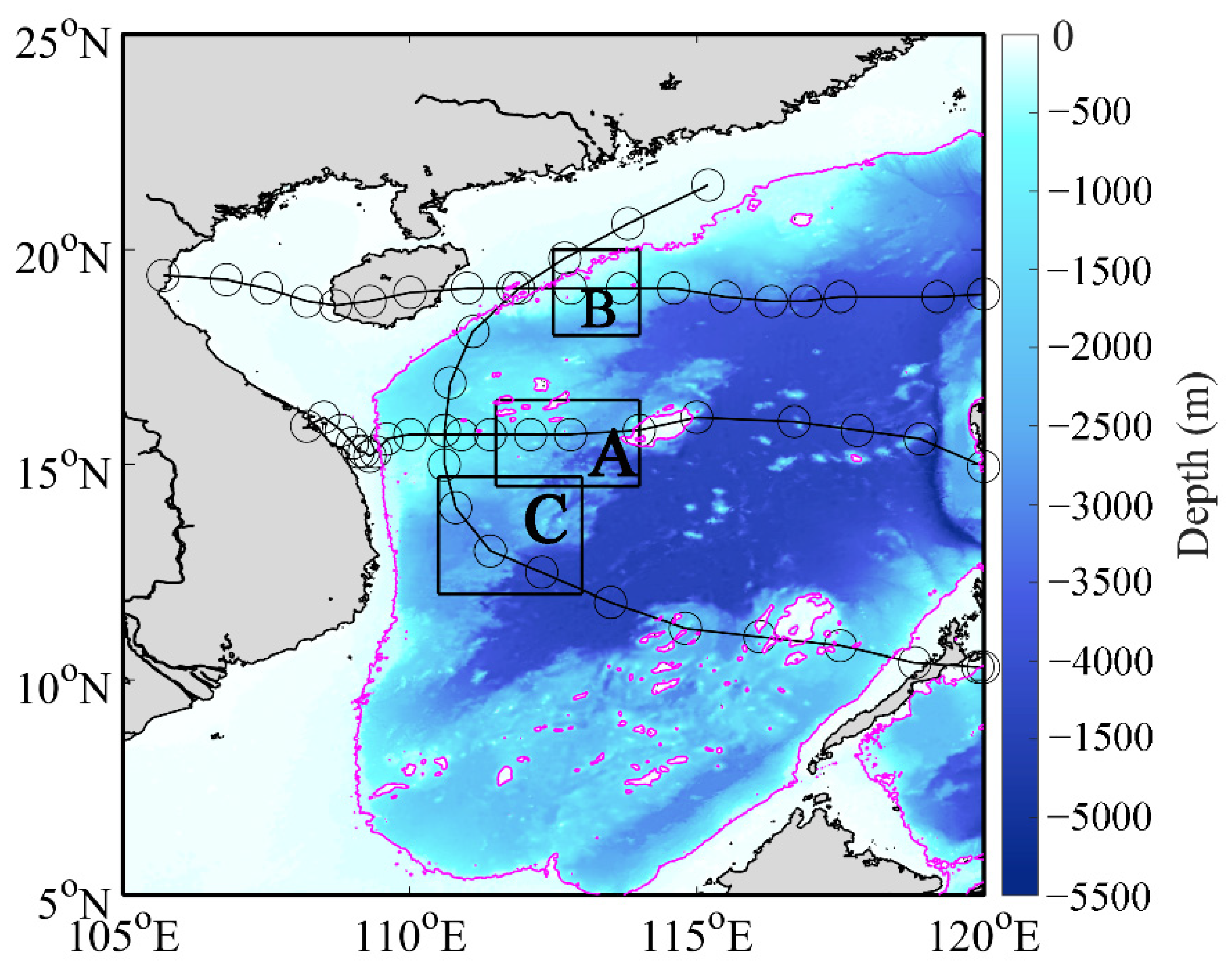

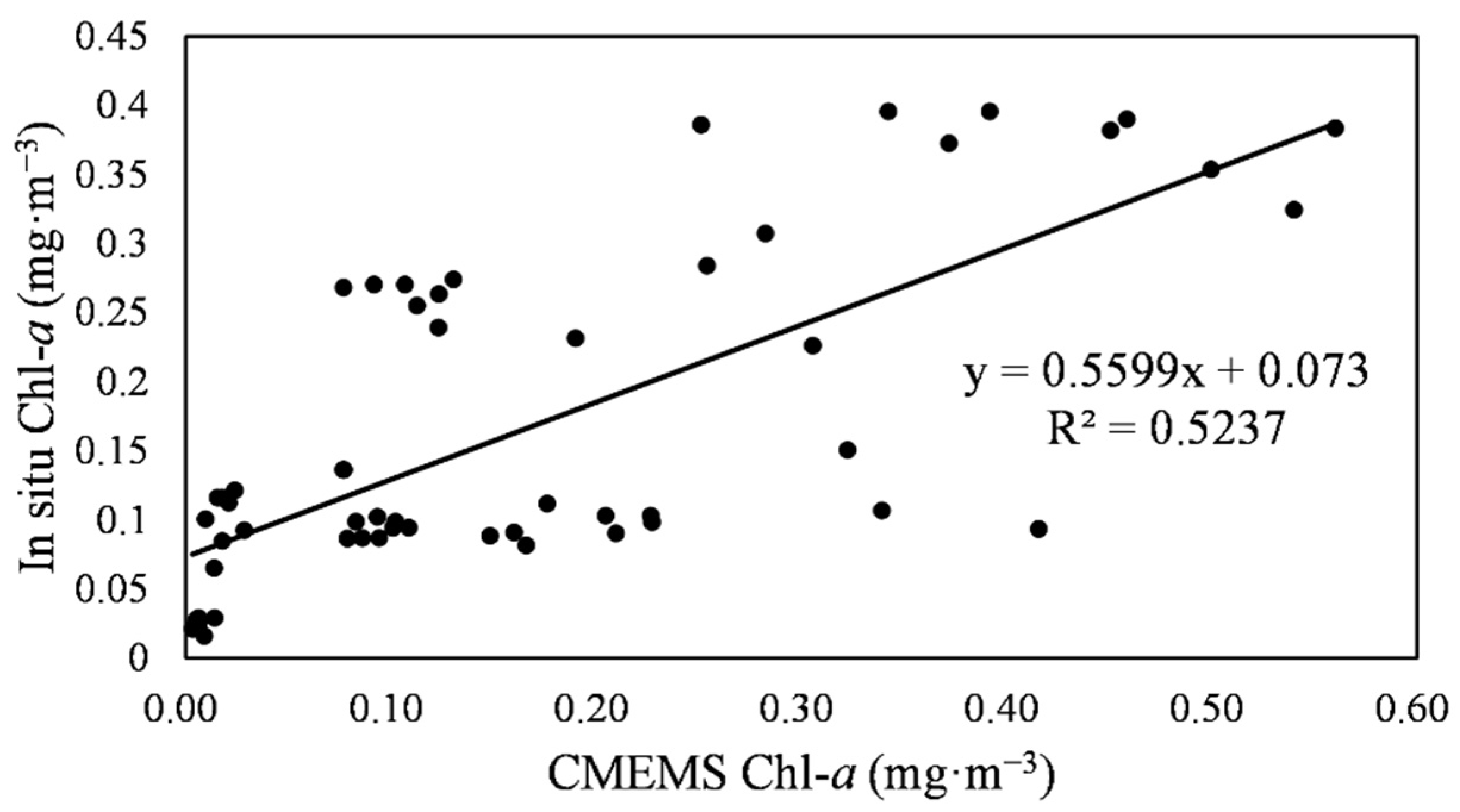
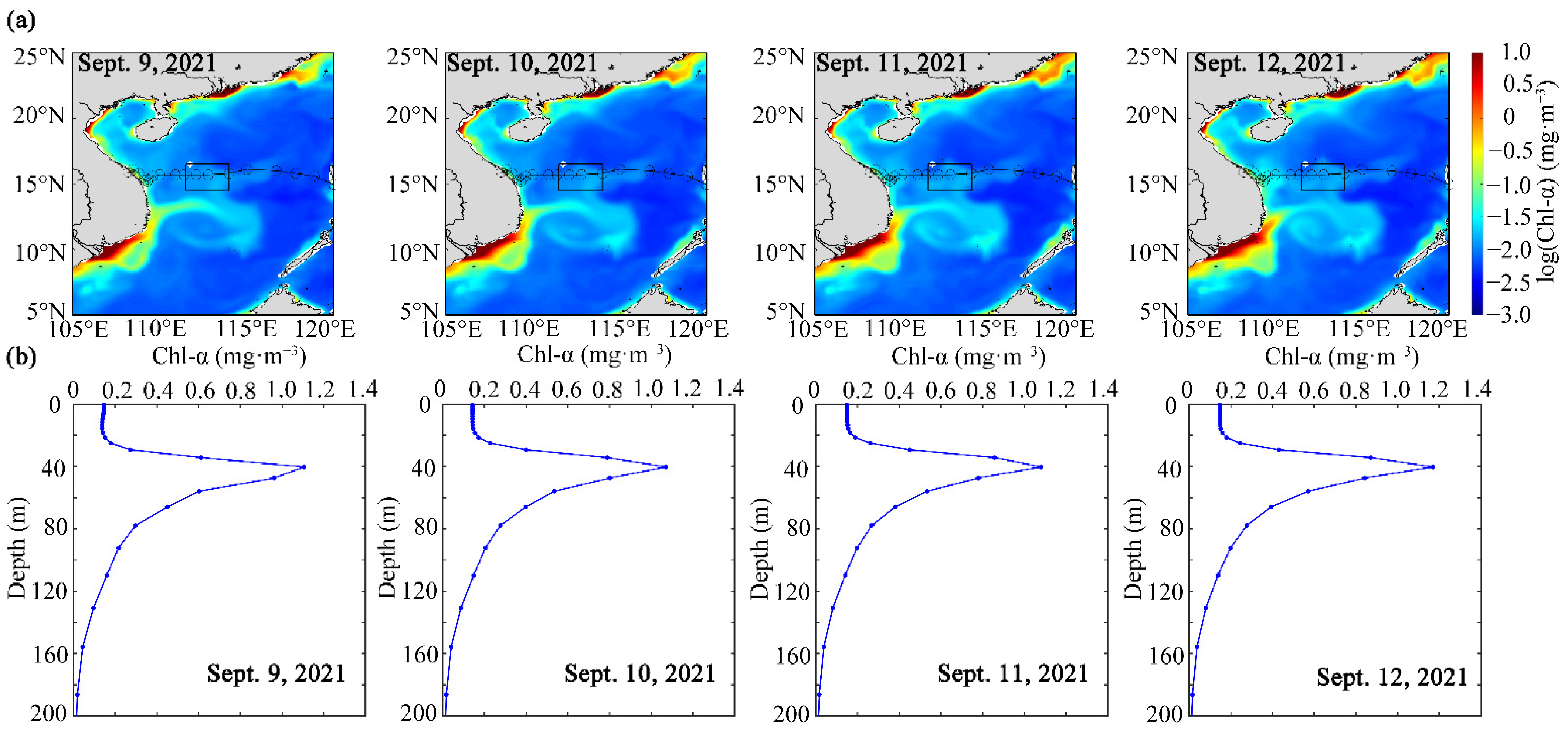

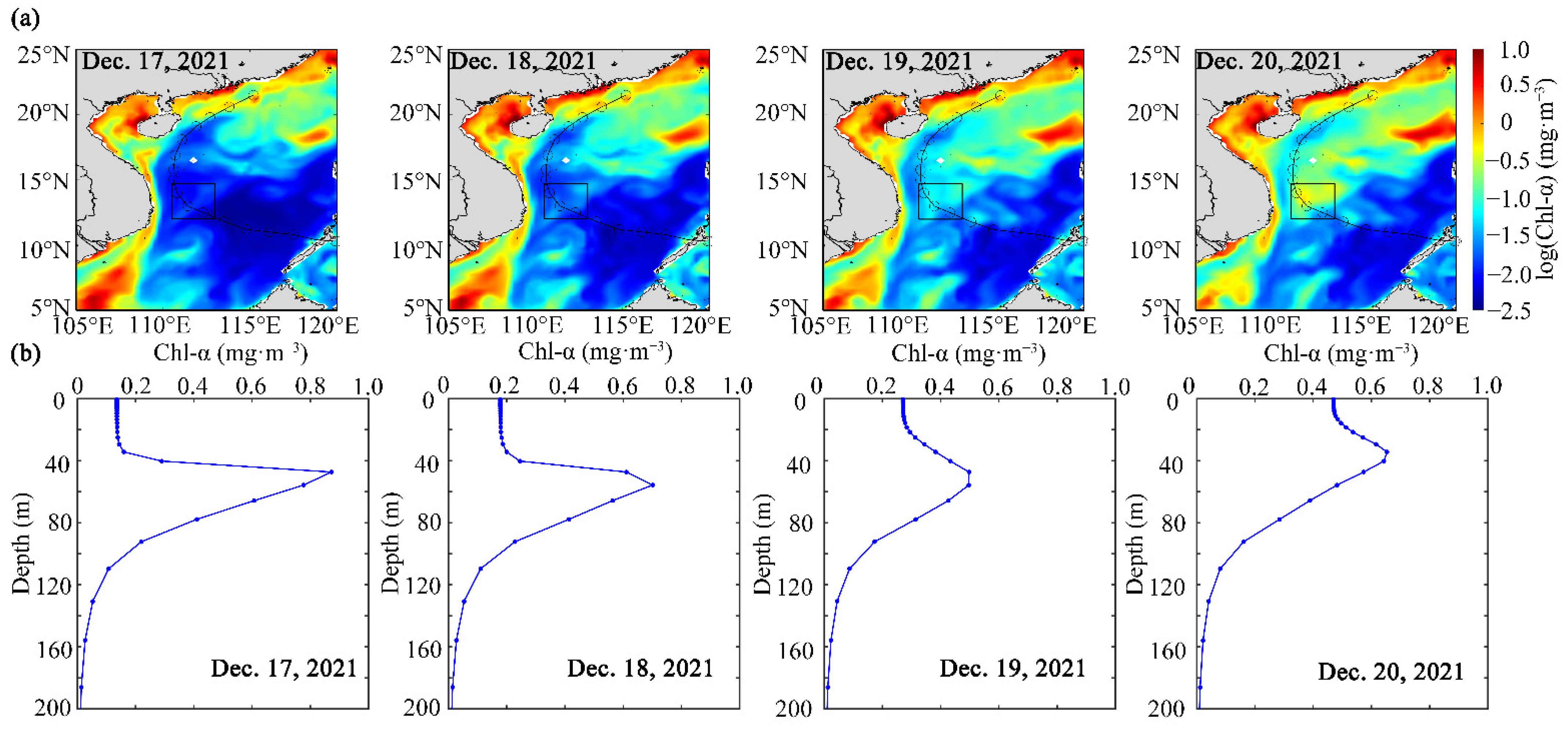
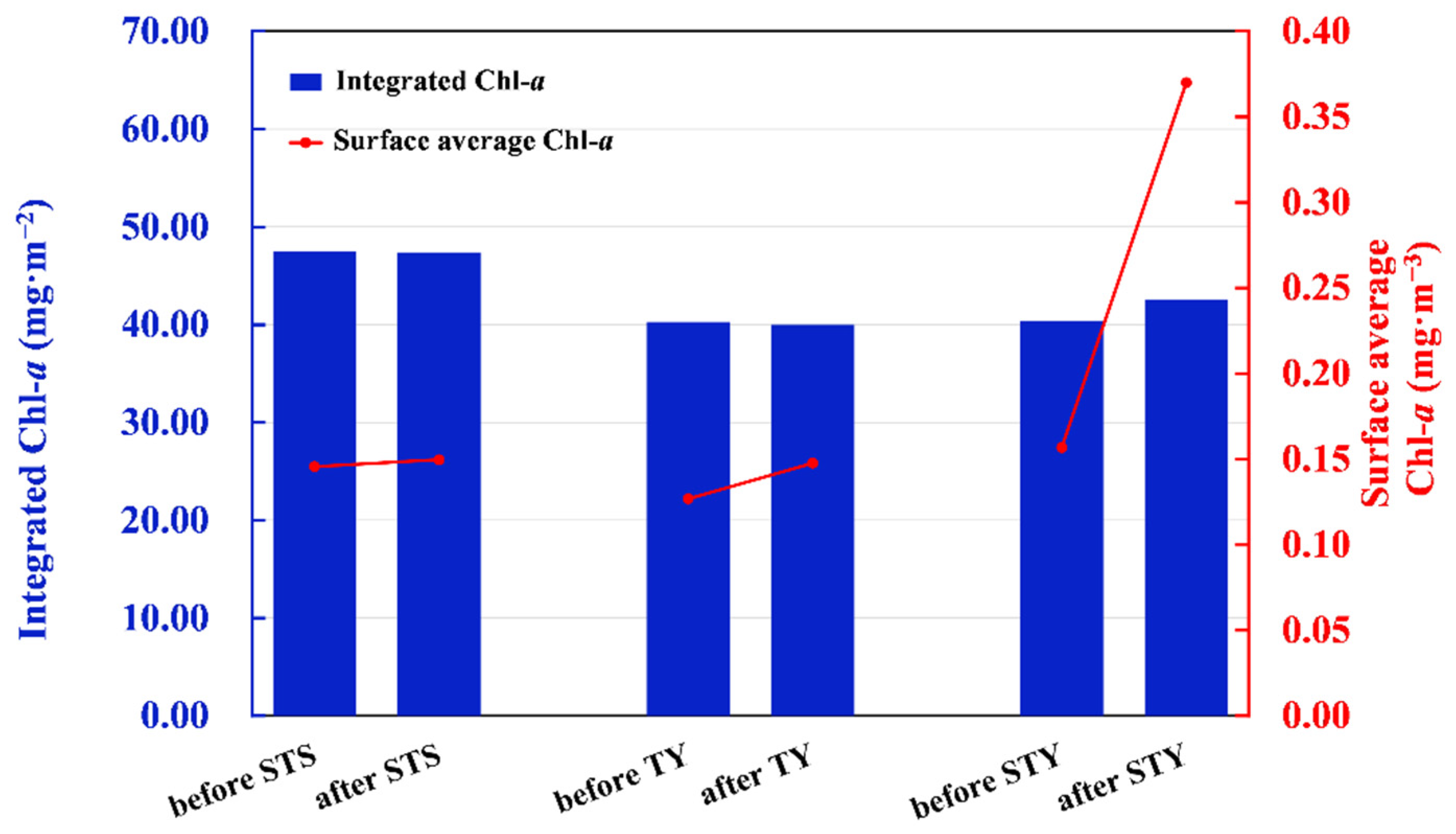


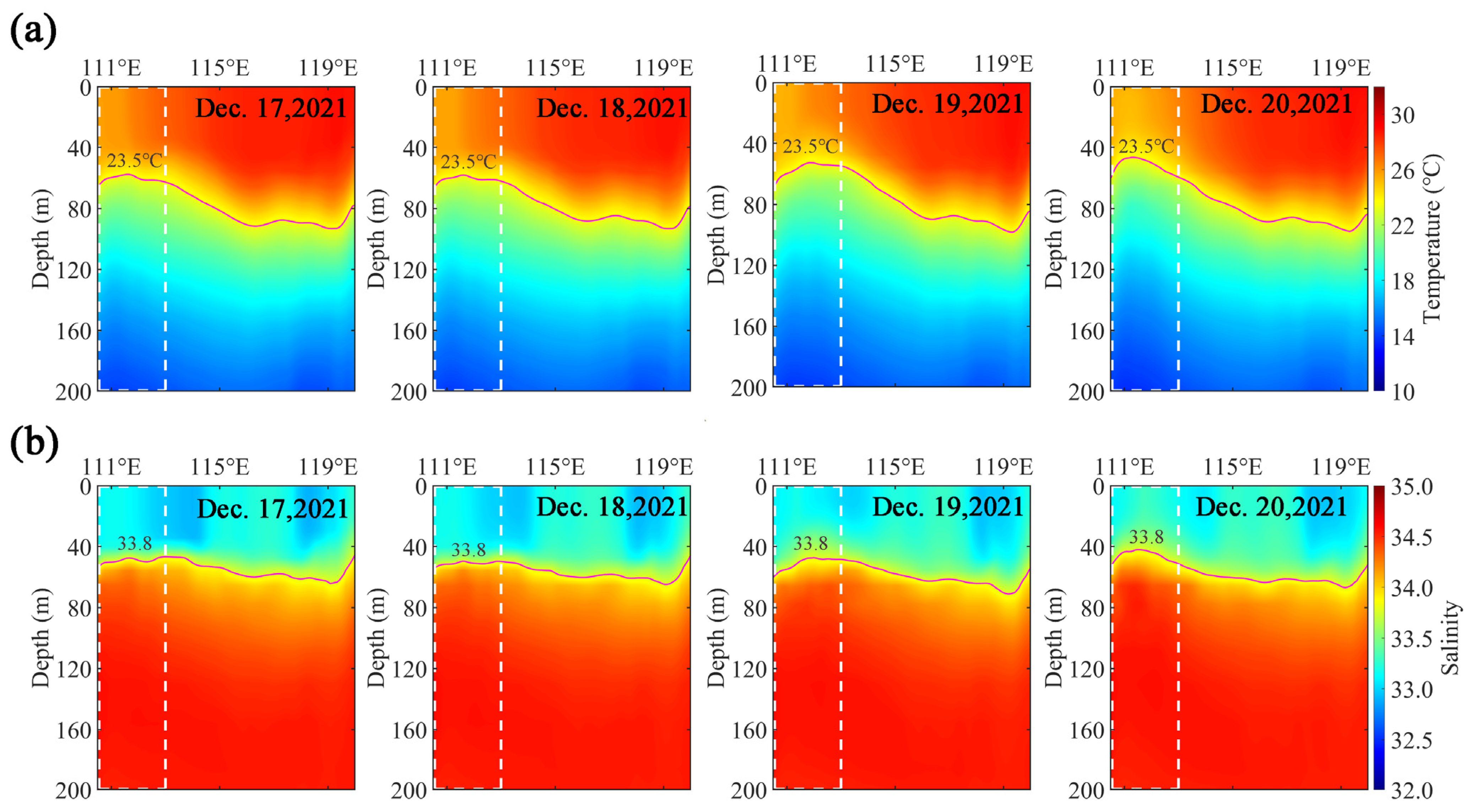
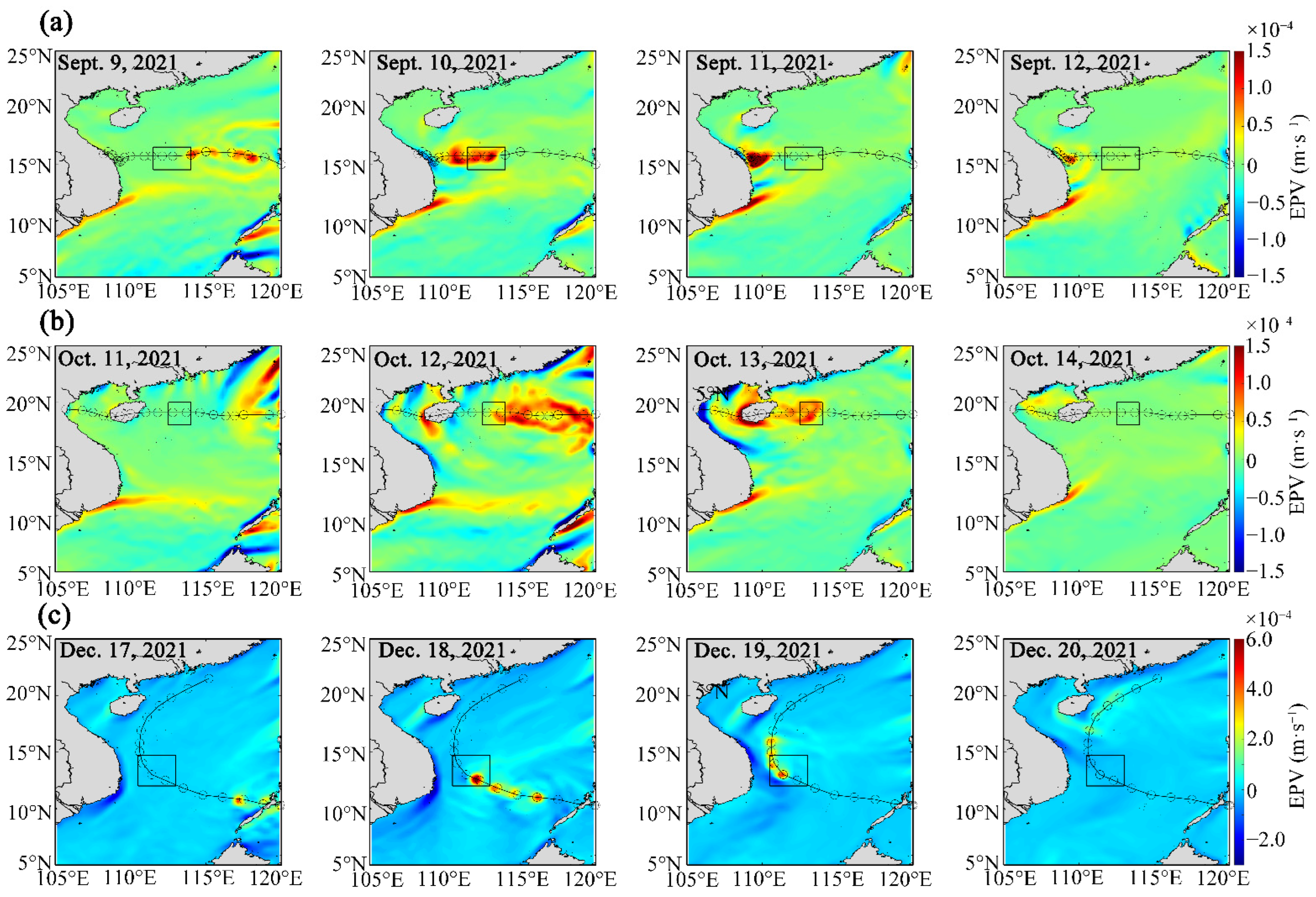
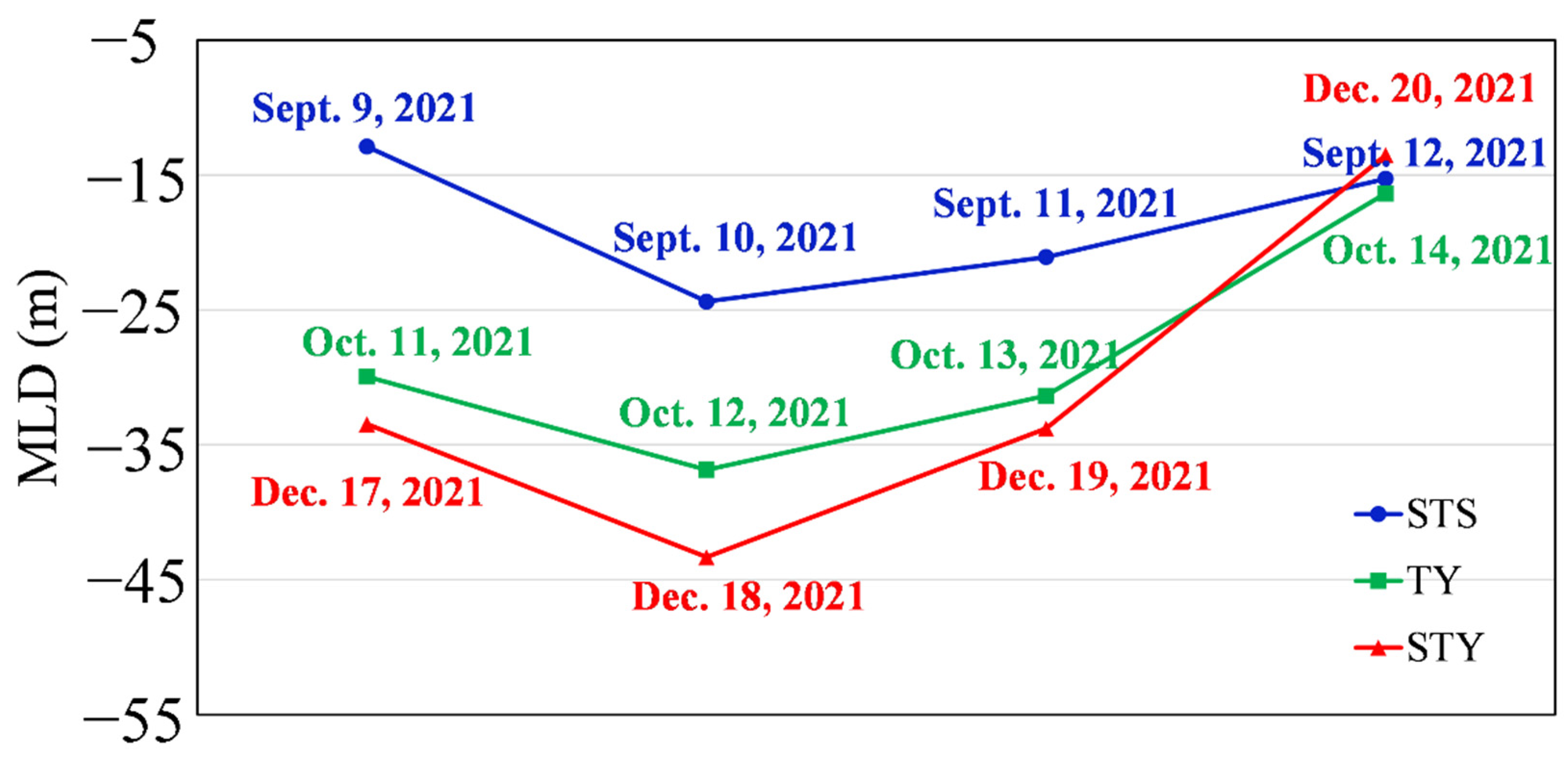
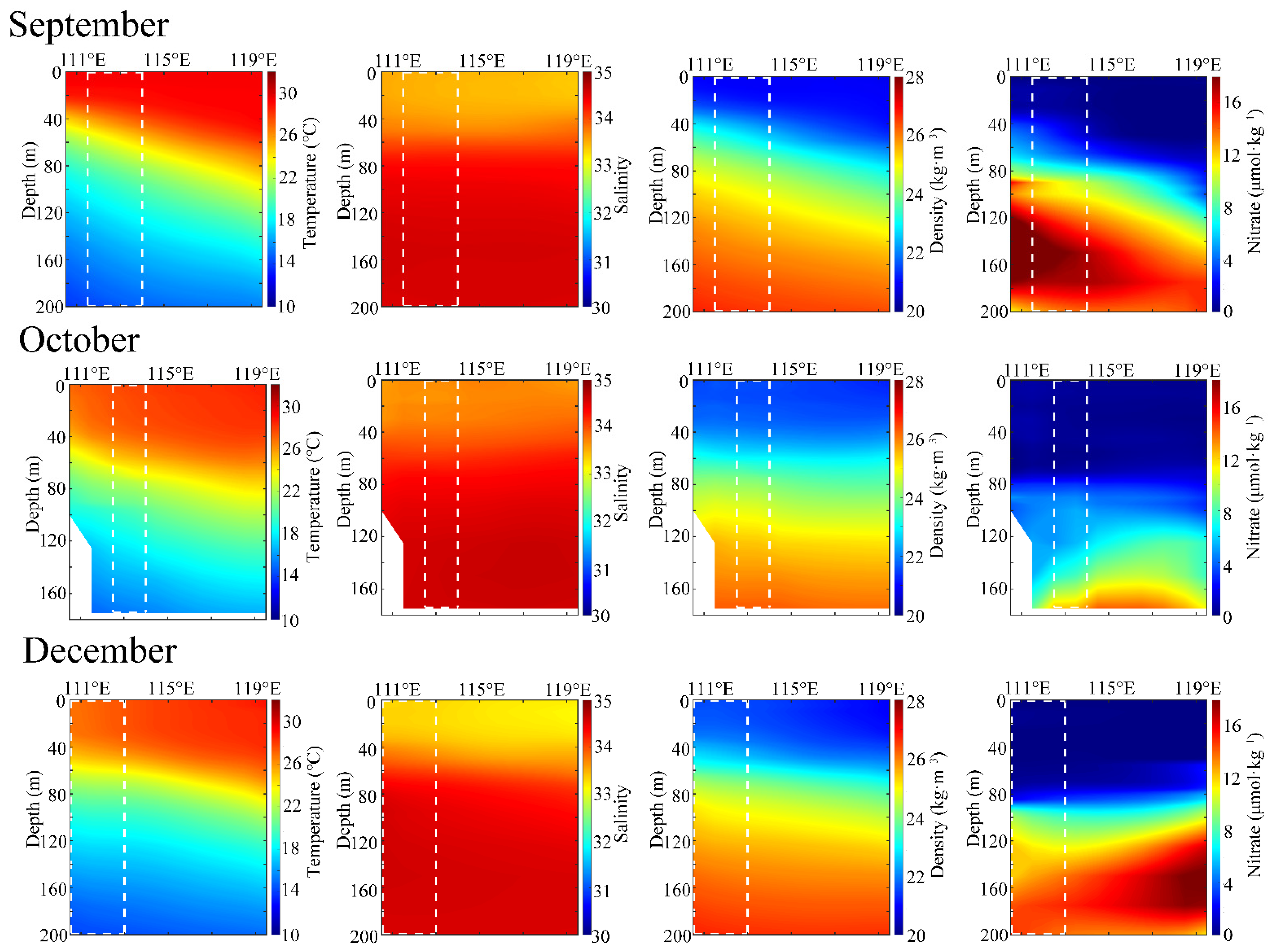
Publisher’s Note: MDPI stays neutral with regard to jurisdictional claims in published maps and institutional affiliations. |
© 2022 by the authors. Licensee MDPI, Basel, Switzerland. This article is an open access article distributed under the terms and conditions of the Creative Commons Attribution (CC BY) license (https://creativecommons.org/licenses/by/4.0/).
Share and Cite
Chen, Y.; Pan, G.; Mortimer, R.; Zhao, H. Possible Mechanism of Phytoplankton Blooms at the Sea Surface after Tropical Cyclones. Remote Sens. 2022, 14, 6207. https://doi.org/10.3390/rs14246207
Chen Y, Pan G, Mortimer R, Zhao H. Possible Mechanism of Phytoplankton Blooms at the Sea Surface after Tropical Cyclones. Remote Sensing. 2022; 14(24):6207. https://doi.org/10.3390/rs14246207
Chicago/Turabian StyleChen, Ying, Gang Pan, Robert Mortimer, and Hui Zhao. 2022. "Possible Mechanism of Phytoplankton Blooms at the Sea Surface after Tropical Cyclones" Remote Sensing 14, no. 24: 6207. https://doi.org/10.3390/rs14246207
APA StyleChen, Y., Pan, G., Mortimer, R., & Zhao, H. (2022). Possible Mechanism of Phytoplankton Blooms at the Sea Surface after Tropical Cyclones. Remote Sensing, 14(24), 6207. https://doi.org/10.3390/rs14246207






